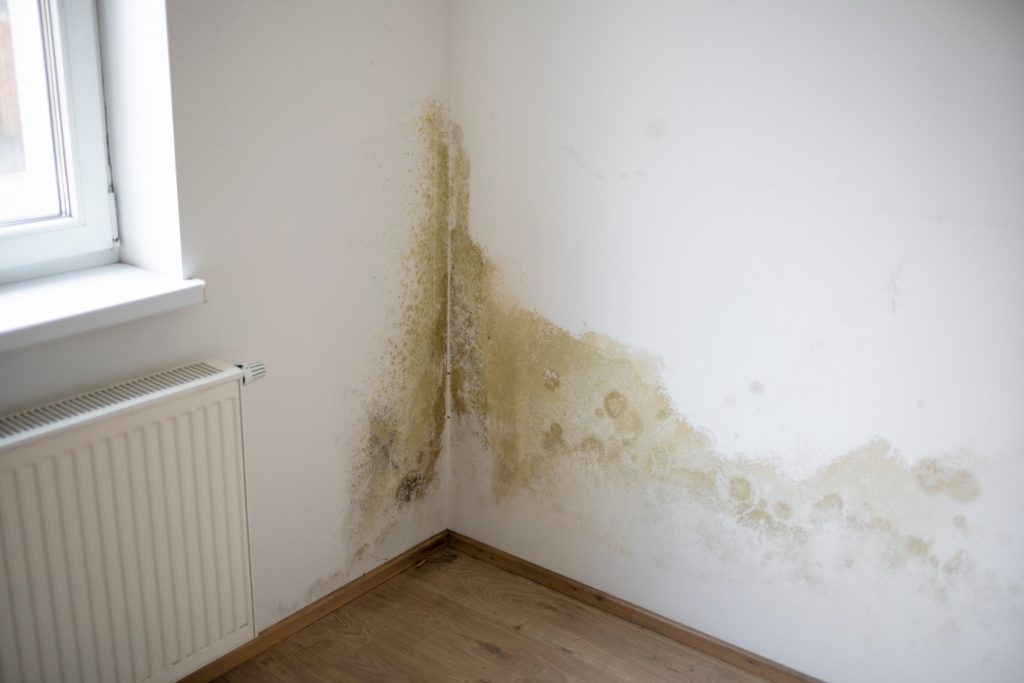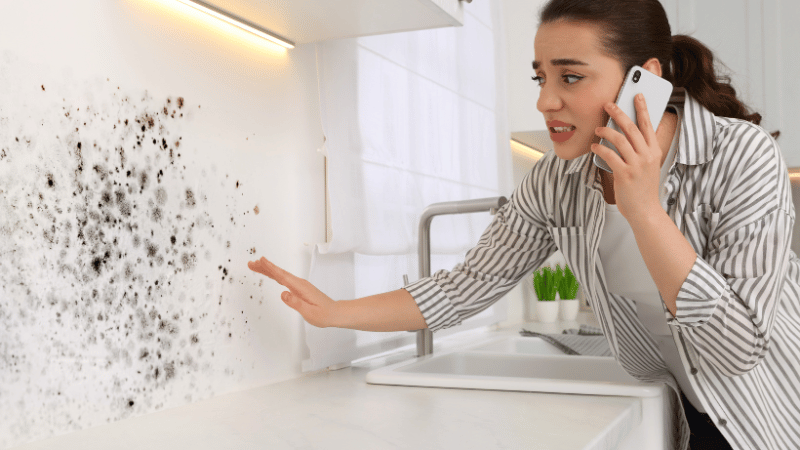Table of Contents
What is Mold?
Mold is a fungus that breaks down organic matter. It can grow indoors or outdoors and is part of the ecosystem. Mold reproduces through spores in the air. When these spores land on suitable surfaces, they can grow into visible colonies. Common indoor molds include Aspergillus, Alternaria, Cladosporium, Penicillium, and Stachybotrys chartarum, or black mold. Mold can be different colors, like white, green, or brown. While most molds are harmless, black mold can produce mycotoxins that may be harmful. Understanding mold and its growth is important for a healthy indoor environment.
Types of Molds
- Cladosporium: This is one of the most common types of mold found both indoors and outdoors. It can grow on various surfaces, including carpets, fabrics, and wood.
- Aspergillus: This type of mold can be found in damp areas such as bathrooms, kitchens, and basements. It can also contaminate food and cause respiratory issues.
- Penicillium: Known for its ability to produce antibiotics, penicillium can also be a common indoor mold. It can grow on food, water-damaged materials, and dust.
- Stachybotrys: Commonly known as black mold, stachybotrys is a toxic mold that thrives in areas with excessive moisture, such as leaky pipes, basements, and bathrooms. It can cause severe health issues if exposed to high levels.
What is White Mold?
White mold is a type of fungus that looks different from other molds. It usually looks like a powdery white substance, but can also be other colors. White mold is often found in places where mold grows, like bathrooms, showers, basements, and crawl spaces. It can also grow in areas that have had flooding or water damage, such as kitchens or basements. It can be hard to tell the difference between white mold, mildew, and efflorescence because of its powdery and filmy texture.
Is White Mold Dangerous?
White mold is a type of fungus, and while all types of mold can be hazardous, white mold in particular may pose some serious health risks. White mold is most often found in damp areas, such as basements or bathrooms where there is an excess of moisture and poor ventilation. This type of mold can produce spores that contain toxic compounds called mycotoxins, which can cause a variety of health issues when inhaled or ingested. The symptoms of white mold exposure can vary from person to person, but may include: headaches, fatigue, coughing, respiratory issues, and skin irritation.
What are the differences between white mold, mildew and efflorescence?
Mildew and white mold are both white growths that can form on surfaces and cause damage, leading to confusion between the two substances. Mildew is usually found growing on plants or other organic matter. It is powdery in nature and generally doesn’t cause damage to materials. On the other hand, white mold penetrates porous materials such as wood or drywall and can cause serious damage. In addition, it can have a damp odor distinct from that of mildew.
Another often misidentified substance is efflorescence. This is caused when salty water seeps through concrete, brick, or stone material and evaporates leaving behind a white crystalline substance with similarities to the appearance of mold but without significant destruction of materials like mold does. Therefore, understanding the differences between these substances can help prevent further damage to structures and save time and money in having to repair them.

What is Black Mold?
Black mold, also known as Stachybotrys chartarum, is a type of fungus that can grow in damp and humid environments. It is often characterized by its dark green or black color and slimy texture. Black mold can be found in various places such as basements, bathrooms, and areas with water damage. It is known for its potential health risks as it releases spores into the air that can cause respiratory problems, allergies, and other health issues. It is important to address and remove black mold promptly to ensure a safe and healthy environment.
What causes black mold?
Black mold is a pervasive type of fungus that can be found almost anywhere in nature. It prefers dark, dampish conditions and will thrive in environments where it has access to oxygen and moisture, which is why we often find it on the walls and ceilings of bathrooms or in basements. It’s particularly fond of areas where water leaks accompany stale air, like around bathtubs or behind furnaces. Aside from its unsightly appearance, black mold can produce spores that cause allergies and respiratory problems, so it’s important to address any possible infestations as soon as possible.
In order for black mold to survive and spread effectively, it needs an environment with both moisture and oxygen present. The presence of even tiny levels of humidity can encourage the growth of fungi like black mold if it has access to enough oxygen. Without moisture, however, black mold will not grow or become active because this is what provide the organisms with the energy they need to survive and multiply. For this reason, eliminating excess moisture in the home is one of the keys to preventing large-scale infestations of black mold.
Is Black Mold Dangerous?
Yes, black mold can be dangerous to both the physical health and the indoor environment. Black mold produces mycotoxins that can cause various health issues when inhaled or touched. Individuals may experience the following symptoms:
- Allergic reactions such as sneezing, coughing, and skin irritations.
- Respiratory issues like wheezing, difficulty breathing, and asthma attacks.
- Headaches, dizziness, and fatigue.
- Long-term exposure can cause more severe health problems like chronic sinus infections, lung infections, and even neurological issues.
Additionally, black mold can cause structural damage to buildings and compromise the air quality, making it important to address any black mold infestations promptly and effectively.
What happens if you breathe in black mold?
Black mold is a type of fungus that grows in moist, dark environments. When black mold spores are inhaled, they can cause an allergic reaction if you have an allergy to black mold. An allergic reaction occurs when your body reacts to the presence of something it is sensitive to – in this case, black mold. The reaction occurs when triggered by immunoglobulin E (IgE) antibodies produced by the immune system after the first exposure to black mold. IgE targets allergens such as black mold and binds to mast cells (histamine-containing cells) in your mucus membranes, skin, gastrointestinal tract and airways. This triggers an allergic response which can manifest in various ways including respiratory distress or skin irritation.
If you have an allergy to black mold and are exposed to it, immediately consult a doctor as soon as possible for treatment advice. Several clinical treatments including antihistamine drugs and leukotriene modifiers may be prescribed depending on your symptoms. If there is evidence of black mold growth in your home or office space then keep the area dry and ventilated as best as possible since dampness encourages the growth of molds like black mold. Seek professional help from a local environmental inspector or remediation specialist if you
How quickly can black mold affect you?
The speed at which black mold can affect an individual depends on various factors such as the person’s overall health, the extent of mold exposure, and the type of mold present. In some cases, individuals may experience symptoms within hours or days of exposure, while others may not show any signs for weeks or even months. Black mold exposure can lead to a range of health issues including respiratory problems, allergies, skin irritation, and even neurological symptoms. It is important to address any mold infestation promptly and seek medical attention if symptoms arise.
Differences Between White Mold and Black Mold
The main differences between white mold and black mold lie in their appearance, growth patterns, and potential health risks.
- White mold is typically powdery or fluffy in appearance, while black mold is usually slimy or greasy.
- White mold often appears on organic materials such as plants, fruits, or bread, while black mold is commonly found on damp or water-damaged surfaces like walls, ceilings, or carpets.
- White mold may have a musty or earthy smell, while black mold often has a strong, unpleasant odor.
- While both types of mold can cause health issues, black mold is generally considered more dangerous and requires immediate attention and professional remediation.
The Importance of Mold Remediation
All molds, white and black, pose a health risk and should be removed from the home. Professionals can assess, identify, and create a plan to remove the mold. Mold needs moisture to grow, so any water damage can cause mold growth. If water damage is ignored, the mold will keep growing and spreading. It can damage belongings, destroy drywall and insulation, and even enter the HVAC ductwork.
Mold can cause damage in your home. React quickly and prevent it from spreading. ServiceMaster by Replacements offers mold remediation services in New Jersey. We find the issue causing water damage and restore the damage caused by water and mold.
To learn more about our mold removal services, make sure to call us today at (732) 842-6917 or fill out a form on our website.







